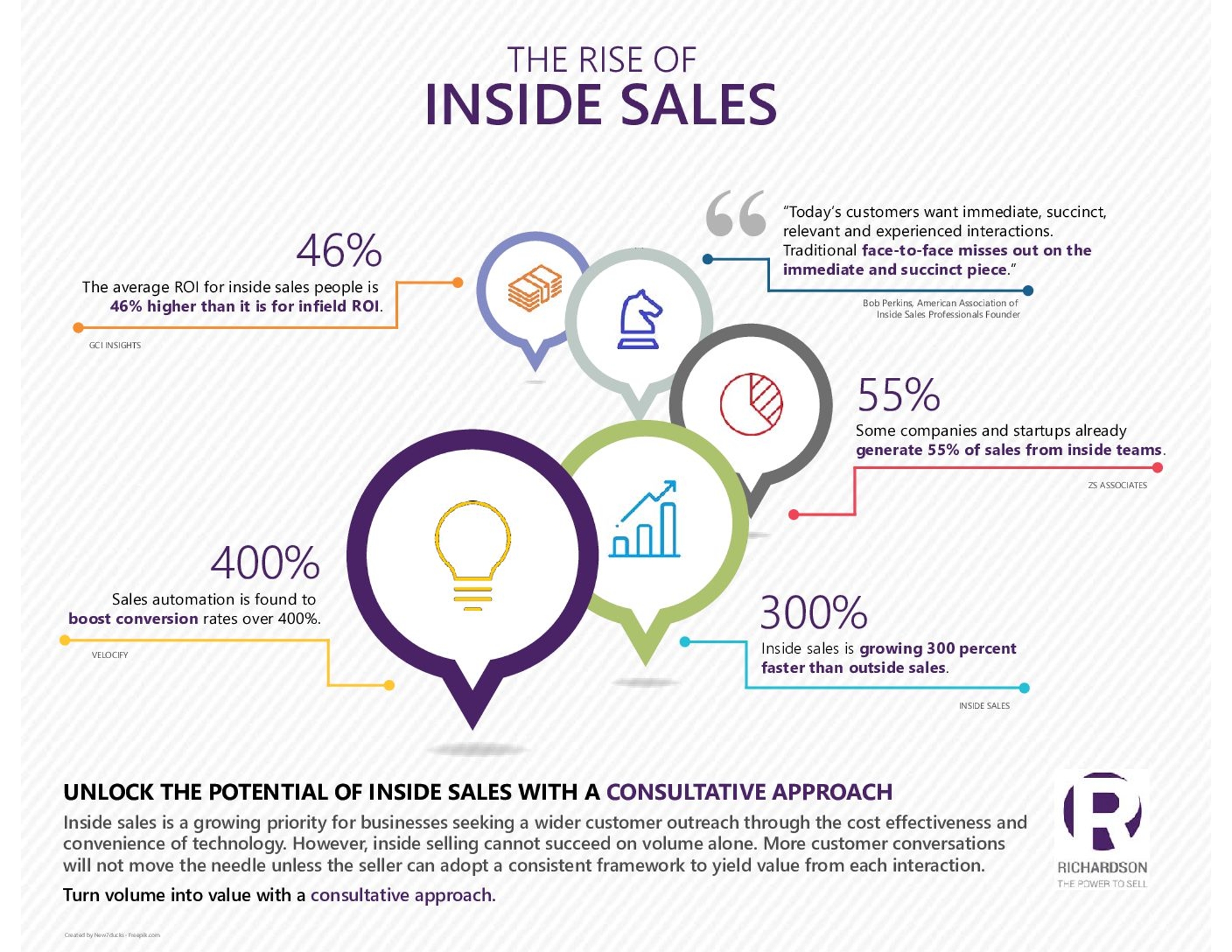Inside Sales Training: Tips & Strategies
Improving win rate

Defining Inside Sales
Inside sales is an approach to selling where the sales professional interacts with customers and prospects through phone calls, email, social media, or other mediated means. Inside sales differs from outside or field sales. Instead, these professionals are not responsible for engaging buyers in face-to-face or offsite meetings.
The Value of Inside Sales
Today, more and more sales organizations are revisiting their inside sales strategies. This is to ensure they are accessing the full potential of their teams.
For example, Astra Zeneca exchanged a field sales team for a 300-person inside sales team. Additionally, IBM accelerated their high-quality inbound lead rate with renewed investment in inside sales. Further, some industries are reporting that 55% of their sales originate from inside teams.

The groundswell of activity around inside sales is in response to the converging influence of competition, budgets, and schedules as well as advancements in social selling, web conferencing, and other sales and marketing automation tools.
These efficiencies offer more cost-effective ways for business development reps to increase leads generated with audio and video. However, in the race to reach more customers, sellers cannot afford to sacrifice quality for volume. The customer must still be part of the equation in inside sales. That's why training for inside sales teams hinges on a consultative approach.
Inside Selling Skills
More customer conversations will not advance the sales cycle unless the seller can adopt a sales process to yield value from each interaction. While efficiencies in technology facilitate the initial contact, sellers need consultative tools to develop that outreach into a sale. There are a few guiding principles that underpin the consultative selling approach. For inside sales teams, these principles are critical to the sales organization's success.
In the relatively short interaction of a sales call, a customer is likely to form a quick positive or negative impression. In fact, the friend/foe bias tells us that all people make this quick assertion.
When a seller appears self-serving or even manipulative, customers identify them as a foe and discredit their message. Sellers must be mindful of this trait and avoid generic solutions. They must do their homework, be relevant, and understand needs before discussing the product.
Sellers don’t need to aggressively hammer a solution. Rather, they can be more effective by floating ideas first.
This practice is the priming bias at work. Customers will become more open to an idea with repeated exposure. As the customer becomes comfortable with an idea, they’re likely to offer their perspective. This equips the seller with valuable feedback to shape the final solution.
The consultative process depends on dialogue. However, the seller must remember to lead the conversation.
From the start of the call, the seller needs to demonstrate their preparation, signaling a clear game plan. They need to maintain focus on the customer without allowing their surroundings to distract them. This approach demonstrates credibility characterized by:
- Strong language designed to shape perceptions
- Comfort with silence to help emphasize key points
- The ability to reference examples of previous, relevant work in the customer’s arena
- A show of preparation and research conducted before the call
- Use of nonverbal cues to underscore messaging
- Concise phrasing that gets to the point
- Assertiveness in asking questions

Custom Sales Academies Drive Continued Performance Improvement
Training is not a one-time event, learn how we can help you develop a sales academy approach to support a long-term performance improvement plan.
Learn MoreInside Sales Tips and Strategies
Inside sales representatives who use a consultative sales approach serve their customers like a valued partner. This partnership shows that they understand their customer's needs and can offer insightful solutions to meet them.
Following these inside sales success tips will improve performance.
Research Customer Needs To Offer Relevant Findings
Inside sales organizations face strong competition. Often their response to this competition is the aggressive promotion of their products and services.
The problem: most other sellers are following this same approach.
Ironically, by attempting to rise above the competition, sellers place themselves right at its center. While it’s important to communicate the value of the solution, sellers must first gain a clear understanding of the customer’s needs.
This crucial first step will help address the common disconnect between a proposed solution and a customer's need. This problem is highlighted in a study from Bain & Company that reports, only 60% of B2B companies believe they do a good job of “aligning offers to target customer segments.” In fact, the same survey of 550 sales executives revealed that only 40% of sales reps have a strong understanding of their company’s differentiation.
By researching potential gaps and needs in advance, inside sales professionals can identify opportunities to create differentiated value. Once these differentiators are understood, sellers can map their capabilities to customer needs.
Ultimately, customers are receptive because the information is relatable. However, keeping the information relevant means avoiding the tendency to show the volume of one’s findings. Sellers must share only the most relevant information — otherwise, they risk losing the customer. Volume doesn’t necessarily equal value.
Legitimize Presence By Creating Context
Nothing discredits an inside sales professional faster than using vague generalities. These make the customer feel like they are on the receiving end of a cold call. Instead, sellers need to build rapport with relevant information.
Context setting starts with a carefully crafted value statement linking the seller’s capabilities to the customer’s challenges. The value statement must address what’s important to the customer, how the sales professional's product or service can help, and what outcomes can be expected. This statement should specifically demonstrate an understanding of the customer’s perspective and pain points. It should also offer ideas that are specific to their industry.
A strong value statement fits the inside selling model because it’s brief. Brevity matters because inside sellers leverage technology to reach more customers in less time. With a concise articulation of value, a seller can form a connection faster over several calls. This connection bolsters the seller’s presence, which helps prevent customers from disengaging from the conversation.
Balance Questioning with Insights
The core of consultative selling is the ability to understand customer needs. It’s also the skill most lacking in sales today.
A study by the Harvard Business Review examines the gap between sellers' expectations and customers' actual needs. They reported, “From the customer’s point of view, the greatest need for improvement is in salespeople’s knowledge of the customer’s business and industry." Sales professionals can remedy this problem by using open-ended sales questions.
Effective questioning starts by providing the rationale for the inquiry. This preface encourages customers to share information. However, questioning shouldn’t be an interrogation. Sellers need to earn the right by balancing their questions with insights.
By offering relevant ideas, the inside sales rep establishes credibility. As the seller moves through these questions, they must acknowledge what the customer said as they lead to the next question.
Consider the Impact of Phrasing
The “framing effect” is a psychological principle asserting that the same person will make two different choices depending on how information is presented.
Research from the Journal of General Internal Medicine supports this idea. In the study, doctors positioned a new prescription in two ways.
They found more patients experienced greater motivation when doctors described the benefits compared to another choice. They were more motivated by this rather than learning about the benefits without context. Framing is a form of positioning. Sellers can put the framing effect to use by emphasizing the value in relative terms.
Once a seller has properly positioned the solution with framing, they must check for feedback. Open-ended questions are an effective way to get the customer’s thoughts. Remember, the risks associated with not knowing the customer’s outlook are greater than any negativity the question may elicit. Though it may feel unnatural, checking for feedback is critical.
Build Knowledge-Based Trust
Follow-up is the most effective way to build credibility. Delivering on a promise, no matter how small, earns the customer’s “knowledge-based” trust. This develops from actions that are consistent with words.
Meanwhile, internal follow-up is equally important. Sharing and recording information about the call shortly after hanging up is critical to preserving the details.
In many cases, the follow-up requires coordination on the part of others. Therefore, the sales professional must remember that even if others are expected to send additional material, it is their job to ensure it happens. This creates a foundation for a long term relationship and partnership with the customer.
Resolve Objections
Objections often stem from cognitive dissonance. This is a tendency to discount, dismiss, or oppose information that is new or conflicts with our beliefs because it creates emotional discomfort. Both customers and sellers are prone to it.
Sellers naturally react defensively to reiterate their points and relieve emotional discomfort. However, this only increases the level of cognitive dissonance for the customer.
Training for inside sales professionals shows how to defuse feelings of defensiveness. To ease the situation, sellers ensure the customer feels heard and understood. They show the customer that they account for their concerns and needs. Even if the objection isn’t fully resolved, the customer should continue to engage in the conversation.
For a better idea of what this looks like, watch the video below for an example of how to effectively resolve customer objections.
Build Self Perception
Consultative Inside Sales doesn’t mandate that one changes who they are. Rather, the consultative framework asks sellers to become more cognizant of how they present themselves. With a greater understanding of one’s strengths and weaknesses, it’s possible to leverage abilities while applying aspects of the framework to areas in need of improvement.
Sellers with a high level of self-perception know which characteristics of the consultative model require more of their attention. They know how they appear. As a result, they can effectively shape the customer's perception.
Be Mindful of Anchoring
Anchoring is the natural tendency to give too much weight to assumptions. These assumptions are involuntary. However, effective sellers make the effort to remain aware of their assumptions.
In doing so, they prevent the error of missing or dismissing valuable information from the customer that might be critical to the sale. Eliciting information from the customer helps customers reveal these assumptions and move past them.
Become an Active Listener
Active listening involves focusing on the customer’s word choice, inflection, and intonation. With attentiveness, an inside sales rep can glean as much information over the phone and video as they would in a face-to-face meeting.
Becoming attuned to the details of the customer’s responses is central to a consultative approach because it clarifies needs. Beware of self-serving motivations and environmental distractions — all of which hinder active listening. Seek to understand, rather than wait to talk.
Let Feedback Guide the Process
Customer feedback offers clues to closing. Take time to check with the customer that the solutions discussed meet their challenges. This information is needed at the moment when the seller can react.
Moreover, the concept of floating ideas is possible due to feedback. Getting the customer’s reactions is critical in keeping ideas malleable. Additionally, asking for the customer’s perspective demonstrates the seller's commitment to a collaborative, consultative process.
As technology, budgets, and schedules present greater influence, inside sales are a priority for most businesses. Therefore, excellence in inside sales, the driver of inside sales, is critical to success today. However, with this approach comes the challenge of establishing value with numerous clients exhibiting different needs. The power of the consultative approach is that it helps sellers apply a consistent methodology to varied customers and ultimately drives more sales.


Consultative Inside Sales Training Program Brochure
Get more information about a training program designed to build the skills inside sales professionals need to succeed.
DownloadGet industry insights and stay up to date, subscribe to our newsletter.
Joining our community gives you access to weekly thought leadership to help guide your planning for a training initiative, inform your sales strategy, and most importantly, improve your team's performance.
.png?auto=webp&width=1920)






